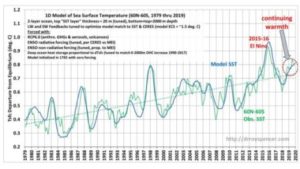by Dr. Roy Spencer, January 13, 2020 in WUWT
The continuing global-average warmth over the last year has caused a few people to ask for my opinion regarding potential explanations. So, I updated the 1D energy budget model I described a couple years ago here with the most recent Multivariate ENSO Index (MEIv2) data. The model is initialized in the year 1765, has two ocean layers, and is forced with the RCP6 radiative forcing scenario and the history of El Nino and La Nina activity since the late 1800s.
The result shows that the global-average (60N-60S) ocean sea surface temperature (SST) data in recent months are well explained as a reflection of continuing weak El Nino conditions, on top of a long-term warming trend.
Fig. 1. 1D model of global ocean temperatures compared to observations. The model is forced with the RCP6 radiative forcing scenario (increasing CO2, volcanoes, anthropogenic aerosols, etc.) and the observed history of El Nino and La Nina since the late 1800s. The observations are monthly running 3-month averages and are offset with a single bias to match the model temperatures, which are departures from assumed energy equilibrium in 1765.
…
…

